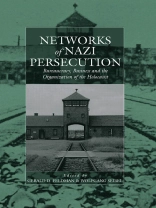The persecution and mass-murder of the Jews during World War II would not have been possible without the modern organization of division of labor. Moreover, the perpetrators were dependent on human and organizational resources they could not always control by hierarchy and coercion. Instead, the persecution of the Jews was based, to a large extent, on a web of inter-organizational relations encompassing a broad variety of non-hierarchical cooperation as well as rivalry and competition. Based on newly accessible government and corporate archives, this volume combines fresh evidence with an interpretation of the governance of persecution, presented by prominent historians and social scientists.
Inhoudsopgave
List of Figures
List of Abbreviations
Introduction: The Holocaust as Division-of-Labor-Based Crime—Evidence and Analytical Challenges
Gerald D. Feldman and Wolfgang Seibel
PART I: RIVALRY AND COMPETITION
Chapter 1. Introduction to Rivalry and Competition
Christian Gerlach
Chapter 2. The SS Security Service and the Gestapo in the National Socialist Persecution of the Jews 1933–1939
Wolfgang Dierker
Chapter 3. “Aryanization” and the Role of the German Banks, 1933–1938
Dieter Ziegler
Chapter 4. The Looting of Jewish Property and Franco-German Rivalry, 1940–1944
Philippe Verheyde
Chapter 5. Seizure of Jewish Property and Inter-Agency Rivalry in the Reich and in the Occupied Soviet Territories
Martin C. Dean
Chapter 6. The Polycratic Nature of Art Looting: The Dynamic Balance of the Third Reich
Jonathan Petropoulos
Chapter 7. The Holocaust and Corruption
Frank Bajohr
Part II: ‘SMOOTH COOPERATION’
Chapter 8. Introduction to “Smooth Cooperation”
Gerhard Hirschfeld and Wolfgang Seibel
Chapter 9. The Looting of Jewish Property and the German Financial Administration
Alfons Kenkmann
Chapter 10. Organized Looting: The Nazi Seizure of Jewish Property in the Netherlands, 1940–1945
Gerard Aalders
Chapter 11. Perpetrator Networks and the Holocaust. The Spoliation of Jewish Property in France, 1940–1944
Marc Olivier Baruch
Chapter 12. ‘Ethnic Resettlement’ and Inter-Agency Cooperation in the Occupied Eastern Territories
Isabel Heinemann
Chapter 13. Der ‘reibungslose’ Holocaust? The German Military and Civilian Implementation of the ‘Final Solution’ in Ukraine, 1941–1944
Wendy Lower
PART III: DECENTRAL INITIATIVE AND VERTICAL INTEGRATION
Chapter 14. A Bureaucratic Holocaust: Toward a New Consensus
Micheal Thad Allen
Chapter 15. Local Initiatives, Central Coordination: German Municipal Administration and the Holocaust
Wolf Gruner
Chapter 16. The Reichskristallnacht and the Insurance Industry: The Politics of Damage Control
Gerald D. Feldman
PART IV: ‘STRUCTURE’, ‘AGENCY’, AND THE LOGIC OF RADICALIZATION
Chapter 17. More than Just a Metaphor: the Network Concept and Its Potential in Holocaust Research
Jörg Raab
Chapter 18. Restraining or Radicalizing? Division of Labor and Persecution Effectiveness
Wolfgang Seibel
Notes on Contributors
Index
Over de auteur
Wolfgang Seibel is Professor of Political Science at the University of Konstanz, Germany. Previous appointments include guest professorships at the Institute for Advanced Study, Vienna (1992), and the University of California at Berkeley (1994). He was also a temporary member of the School of Social Science (1989/90) and of the School of Historical Studies (2003) of the Institute of Advanced Study, Princeton. Currently (2004/2005) he is a fellow of the Wissenschaftskolleg zu Berlin. His research is mainly devoted to issues of politics, public bureaucracy and non-governmental organizations.












